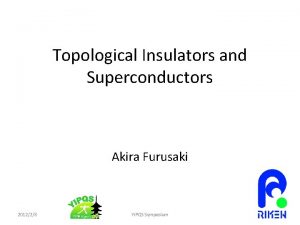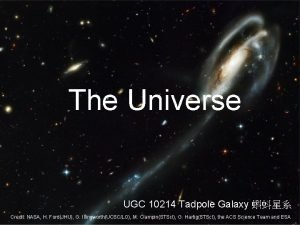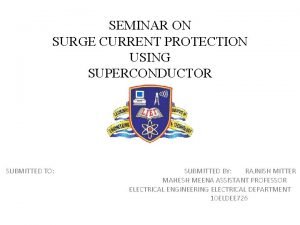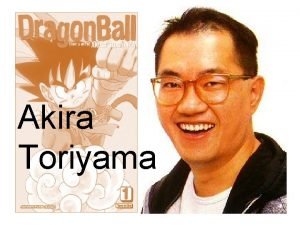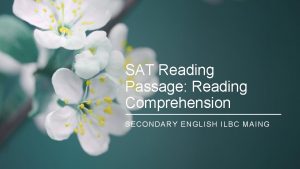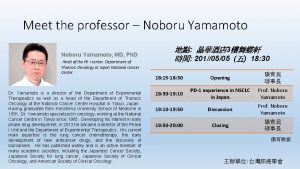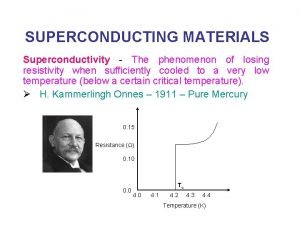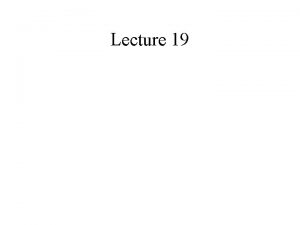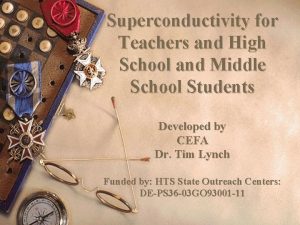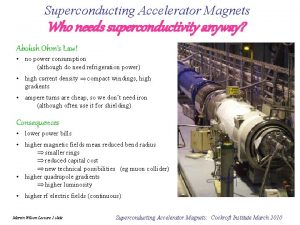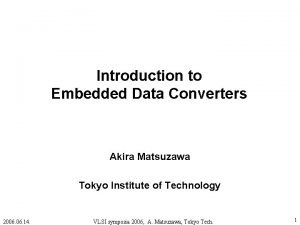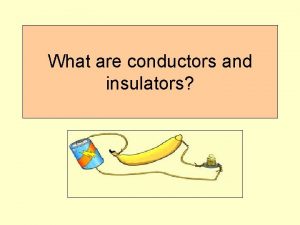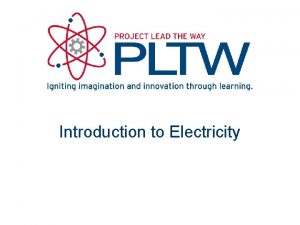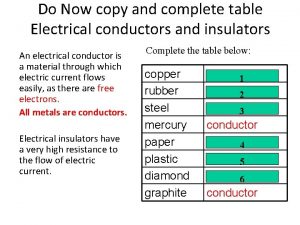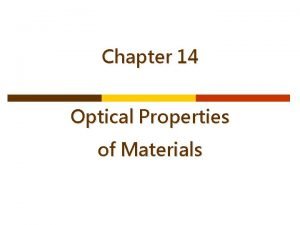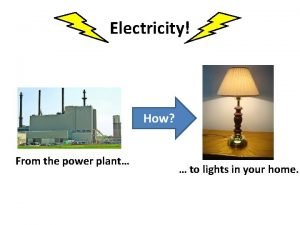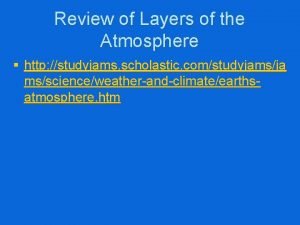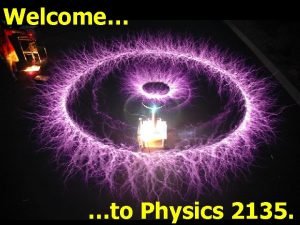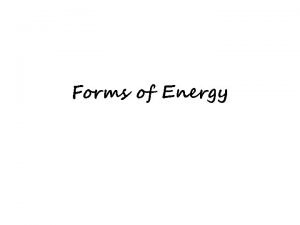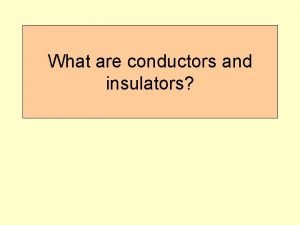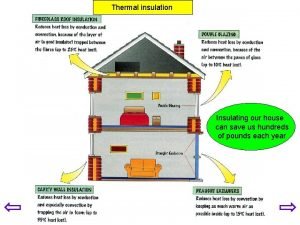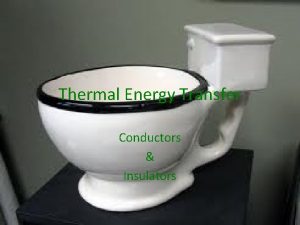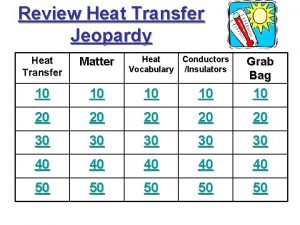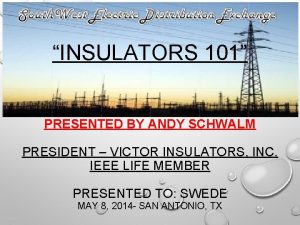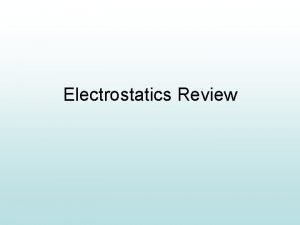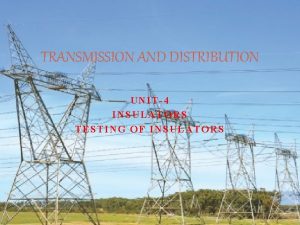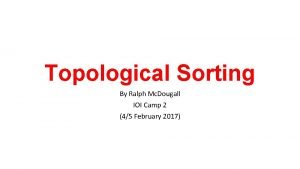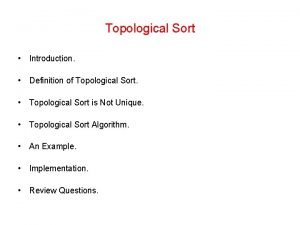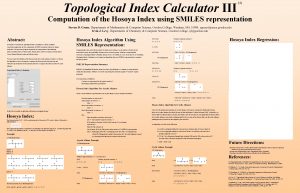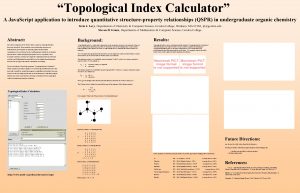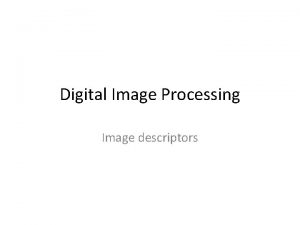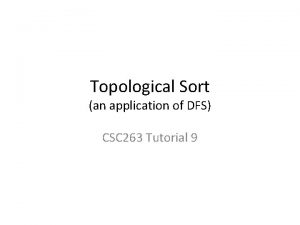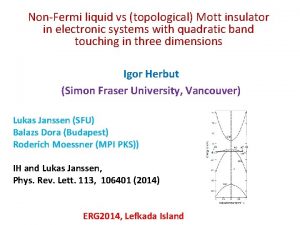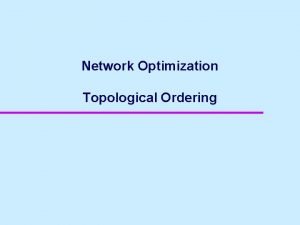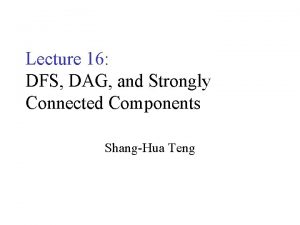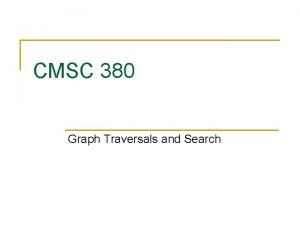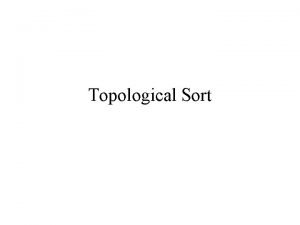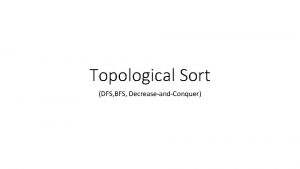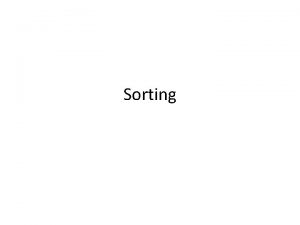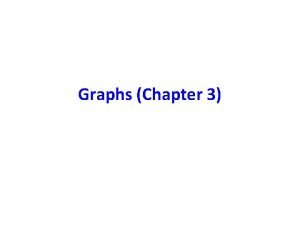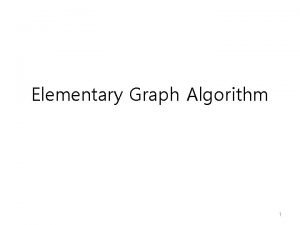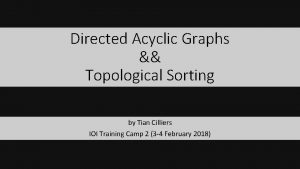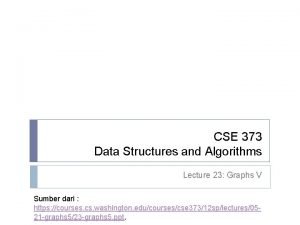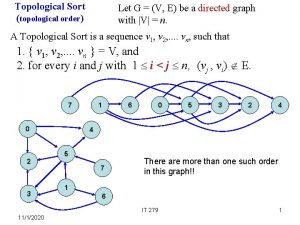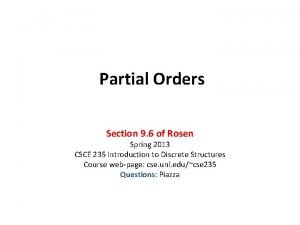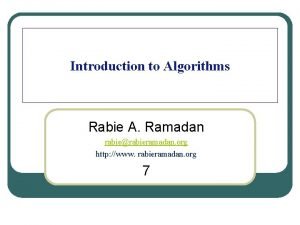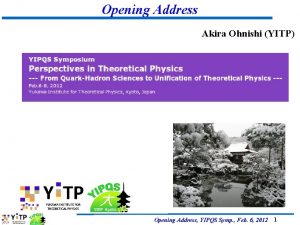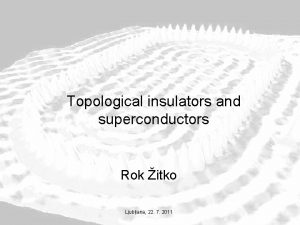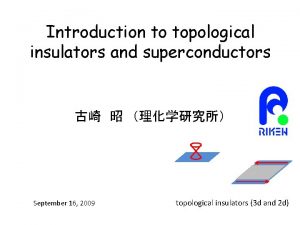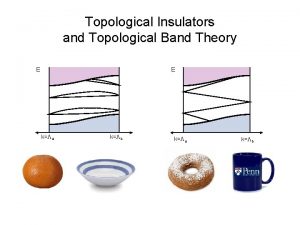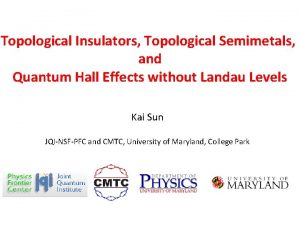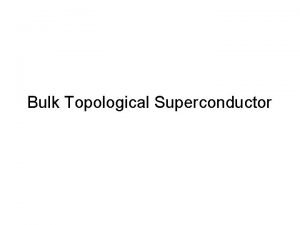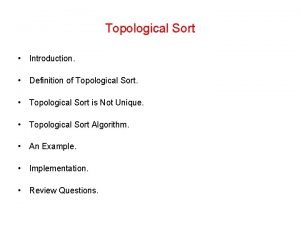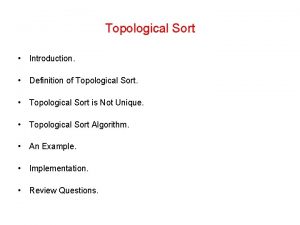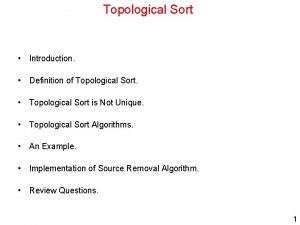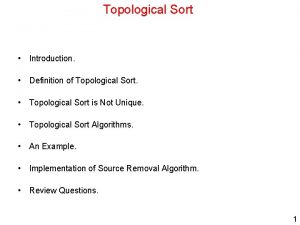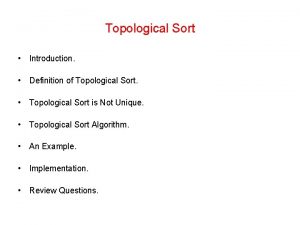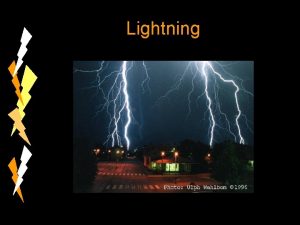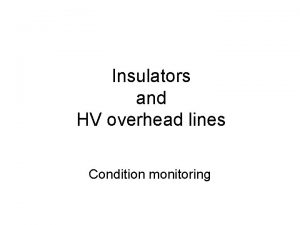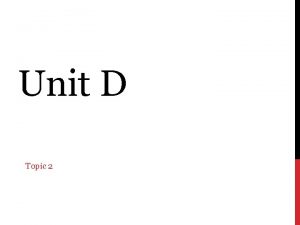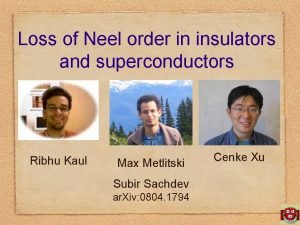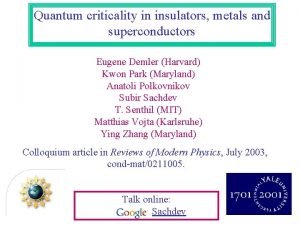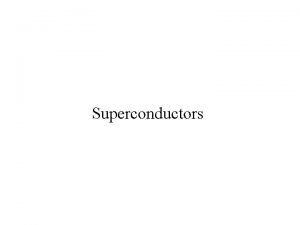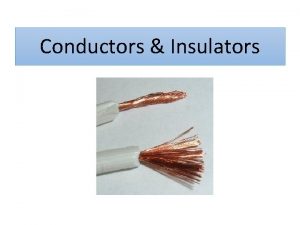Topological Insulators and Superconductors Akira Furusaki 201228 YIPQS


















































- Slides: 50

Topological Insulators and Superconductors Akira Furusaki 2012/2/8 YIPQS Symposium 1

Condensed matter physics • Diversity of materials – Understand their properties – Find new states of matter “More is different” (P. W. Anderson) • Emergent behavior of electron systems at low energy – Spontaneous symmetry breaking crystal, magnetism, superconductivity, …. – Fermi liquids (non-Fermi liquids) (high-Tc) superconductivity, quantum criticality, … – Insulators Mott insulators, quantum Hall effect, topological insulators, …

Outline • Topological insulators: introduction • Examples: – – – Integer quantum Hall effect Quantum spin Hall effect 3 D Z 2 topological insulator Topological superconductor Classification • Summary and outlook

Introduction • Topological insulator – an insulator with nontrivial topological structure – massless excitations live at boundaries bulk: insulating, surface: metallic • Many ideas from field theory are realized in condensed matter systems – anomaly – domain wall fermions –… • Recent reviews: – Z. Hasan & C. L. Kane, RMP 82, 3045 (2010) – X. L. Qi & S. C. Zhang, RMP 83, 1057 (2011)

Recent developments 2005 - • Insulators which are invariant under time reversal can have topologically nontrivial electronic structure • 2 D: Quantum Spin Hall Effect – theory C. L. Kane & E. J. Mele 2005; A. Bernevig, T. Hughes & S. C. Zhang 2006 – experiment L. Molenkamp’s group (Wurzburg) 2007 Hg. Te • 3 D: Topological Insulators in the narrow sense – theory L. Fu, C. L. Kane & E. J. Mele 2007; J. Moore & L. Balents 2007; R. Roy 2007 – experiment Z. Hasan’s group (Princeton) 2008 Bi 1 -x. Sbx Bi 2 Se 3 , Bi 2 Tl 2 Se, …. .

Topological insulators • band insulators in broader sense free fermions (ignore e-e int. ) • characterized by a topological number (Z or Z 2) Chern #, winding #, … • gapless excitations at boundaries stable Topological non-topological (vacuum) insulator Examples: integer quantum Hall effect, polyacetylen, quantum spin Hall effect, 3 D topological insulator, …. 6

Band insulators • An electron in a periodic potential (crystal) • Bloch’s theorem Brillouin zone empty band gap Band insulator occupied 0

Energy band structure: a mapping Topological equivalence (adiabatic continuity) Band structures are equivalent if they can be continuously deformed into one another without closing the energy gap 8

Topological distinction of ground states deformed “Hamiltonian” n empty bands m filled bands map from BZ to Grassmannian IQHE (2 dim. ) homotopy class 9

Berry phase of Bloch wave function Berry connection Berry curvature Berry phase Example: 2 -level Hamiltonian (spin ½ in magnetic field) 10

Integer QHE 11

Integer quantum Hall effect (von Klitzing 1980) Quantization of Hall conductance exact, robust against disorder etc. 12

Integer Quantum Hall Effect (TKNN: Thouless, Kohmoto, Nightingale & den Nijs 1982) Chern number integer valued = number of edge modes crossing EF bulk-edge correspondence filled band Berry connection 13

Lattice model for IQHE (Haldane 1988) • Graphene: a single layer of graphite – Relativistic electrons in a pencil Geim & Novoselov: Nobel prize 2010 B A K K’ K K Matrix element for hopping between nearest-neighbor sites: t E K’ px py K’ A B

Dirac masses • Staggered site energy (G. Semenoff 1984) Breaks inversion symmetry • Complex 2 nd-nearest-neighbor hopping (Haldane 1988) No net magnetic flux through a unit cell Breaks time-reversal symmetry Hall conductivity Chern insulator

Massive Dirac fermion: a minimal model for IQHE parity anomaly (2+1)d Chern-Simons theory for EM Domain wall fermion 16

Quantum spin Hall effect (2 D Z 2 topological insulator) 17

2 D Quantum spin Hall effect Kane & Mele (2005, 2006); Bernevig & Zhang (2006) • time-reversal invariant band insulator • spin-orbit interaction • gapless helical edge mode (Kramers’ pair) up-spin electrons conduction band down-spin electrons valence band Sz is not conserved in general. Topological index: Z Z 2 18

Quantum spin Hall insulator Bulk energy gap & gapless edge states Helical edge states: (i) Half an ordinary 1 D electron gas (ii) Protected by time reversal symmetry 19

Kane-Mele model • Two copies of Haldane’s model (spin up & down) + spin-flip term down-spin electrons up-spin electrons • Invariant under time-reversal transformation • Spin-flip term breaks – – symmetry two copies of Chern insulators a new topological number: Z 2 index

Effective Hamiltonian • • • complex 2 nd nearest-neighbor hopping (Haldane) spin-flip hopping staggered site potential (Semenoff) Time-reversal symmetry Chern # = 0 complex conjugation

Z 2 index Kane & Mele (2005); Fu & Kane (2006) Quantum spin Hall insulator conduction band Trivial insulator an odd number of crossing valence band conduction band an even number of crossing valence band Bloch wave of occupied bands Time-reversal invariant momenta: antisymmetric Z 2 index

Time reversal symmetry Time reversal operator Kramers’ theorem time-reversal pair All states are doubly degenerate. 23

Z 2: stability of gapless edge states (1) A single Kramers doublet E E Kramers’ theorem stable k k (2) Two Kramers doublets E E k k Two pairs of edge states are unstable against perturbations that respect TRS. 24

Experiment Hg. Te/(Hg, Cd)Te quantum wells Cd. Te Hg. Cd. Te Konig et al. [Science 318, 766 (2007)] Trivial Ins. QSHI 25

Z 2 topological insulator in 3 spatial dimensions 26

3 dimensional Topological insulator • Band insulator Z 2 topologically nontrivial • Metallic surface: massless Dirac fermions (Weyl fermions) Theoretical Predictions made by: Fu, Kane, & Mele (2007) Moore & Balents (2007) Roy (2007) an odd number of Dirac cones/surface

Surface Dirac fermions topological insulator • “ 1/4” of graphene K E K’ K’ K K K’ kx ky • An odd number of Dirac fermions in 2 dimensions cf. Nielsen-Ninomiya’s no-go theorem 28

Experimental confirmation • Bi 1 -x. Sbx 0. 09<x<0. 18 theory: Fu & Kane (PRL 2007) exp: Angle Resolved Photo Emission Spectroscopy Princeton group (Hsieh et al. , Nature 2008) 5 surface bands cross Fermi energy • Bi 2 Se 3 ARPES exp. : Xia et al. , Nature Phys. 2009 photon p, E a single Dirac cone Other topological insulators: Bi 2 Te 3, Bi 2 Te 2 Se, …

Response to external EM field Qi, Hughes & Zhang, 2008 Essin, Moore & Vanderbilt 2009 Integrate out electron fields to obtain effective action for the external EM field axion electrodynamics (Wilczek, …) time reversal trivial insulators topological insulators (2+1)d Chern-Simons theory topological insulator

Topological magnetoelectric effect Magnetization induced by electric field Polarization induced by magnetic field

Topological superconductors

Topological superconductors • • BCS superconductors Quasiparticles are massive inside the superconductor Topological numbers Majorana (Weyl) fermions at the boundaries stable topological superconductor vacuum (topologically trivial) Examples: p+ip superconductor, fractional QHE at , 3 He

Majorana fermion Ettore Majorana mysteriously disappeared in 1938 • Particle that is its own anti-particle • Neutrino ? • In superconductors: condensation of Cooper pairs nothing (vacuum) particle hole Quasiparticle operator This happens at E=0.

2 D p+ip superconductor • (px+ipy)-wave Cooper pairing • Hamiltonian for Nambu spinor (similar to IQHE) angular momentum = (spinless case) wrapping # = 1 • Majorana Weyl fermion along the edge px+ipy px-ipy

Majorana zeromode in a quantum vortex Zero-energy Majorana bound state (p+ip) superconductor zero mode Majorana fermion energy spectrum near a vortex If there are 2 N vortices, then the ground-state degeneracy = 2 N.

interchanging vortices i braid groups, non-Abelian statistics i+1 (p+ip) superconductor D. A. Ivanov, PRL (2001) topological quantum computing ? Majorana zeromode is insensitive to external disturbance (long coherence time).

Engineering topological superconductors • 3 D topological insulator + s-wave superconductor (Fu & Kane, 2008) s-SC S-wave SC Dirac mass for the (2+1)d surface Dirac fermion Similar to a spinless p+ip superconductor Z 2 TPI Majorana zeromode in a vortex core (cf. Jakiw & Rossi 1981) • Quantum wire with strong spin-orbit coupling + B field + s-SC (Das Sarma et al, Alicea, von Oppen, Oreg, … Sato-Fujimoto-Takahashi, …. ) In. As, In. Sb wire B s-SC • Race is on for the search of elusive Majorana!

Classification of topological insulators and superconductors

Q: How many classes of topological insulators/superconductors exist in nature? A: There are 5 classes of TPIs or TPSCs in each spatial dimension. Generic Symmetries: time reversal charge conjugation (particle hole) SC 40

Classification of free-fermion Hamiltonian in terms of generic discrete symmetries • Time-reversal symmetry (TRS) anti-unitary spin 0 spin 1/2 • Particle-hole symmetry (PHS) Bd. G Hamiltonian triplet anti-unitary singlet • TRS PHS = Chiral symmetry (CS) 41

10 random matrix ensembles (symmetric spaces) Altland & Zirnbauer (1997) TRS PHS Ch time evolution operator IQHE Wigner. Dyson Z 2 TPI chiral px+ipy superconductor • Wigner-Dyson (1951 -1963): “three-fold way” complex nuclei • Verbaarschot & others (1992 -1993) chiral phase transition in QCD 42 • Altland-Zirnbauer (1997): “ten-fold way” mesoscopic SC systems

10 random matrix ensembles (symmetric spaces) Altland & Zirnbauer (1997) TRS PHS Ch time evolution operator IQHE Wigner. Dyson Z 2 TPI chiral px+ipy superconductor “Complex” cases: A & AIII “Real” cases: the remaining 8 classes 43

How to classify topological insulators and SCs • Gapless boundary modes are topologically protected. • They are stable against any local perturbation. (respecting discrete symmetries) • They should never be Anderson localized by disorder. Nonlinear sigma models for Anderson localization of gapless boundary modes + topological term (with no adjustable parameter) Z 2 top. term bulk: d dimensions boundary: d -1 dimensions WZW term -term 44

NLSM topological terms Z 2: Z 2 topological term can exist in d dimensions Z: WZW term can exist in d-1 dimensions d+1 dim. TI/TSC d dim. TI/TSC

Classification of topological insulators/superconductors Standard (Wigner-Dyson) Chiral Bd. G TRS PHS CS d=1 d=2 A (unitary) 0 0 0 -- Z AI (orthogonal) +1 0 0 -- -QSHE -- AII (symplectic) 1 0 0 -- Z 2 Z 2 TPI -- Z AIII (chiral unitary) 0 0 1 Z BDI (chiral orthogonal) +1 +1 1 Z CII (chiral symplectic) 1 1 1 Z IQHE -- polyacetylene (SSH) ---- 0 p SC Z 2 Z D (p-wave SC) 0 +1 C (d-wave SC) 0 1 0 -- Z DIII (p-wave TRS SC) 1 +1 1 Z 2 CI (d-wave TRS SC) +1 1 Schnyder, Ryu, AF, and Ludwig, PRB (2008) d=3 Z 2 p+ip SC -- d+id SC 1 (p+ip)x(p-ip) ---SC -Z 3 He-B Z 46

Periodic table of topological insulators/superconductors period d=2 period d=8 A. Kitaev, AIP Conf. Proc. 1134, 22 (2009); ar. Xiv: 0901. 2686 K-theory, Bott periodicity Ryu, Schnyder, AF, Ludwig, NJP 12, 065010 (2010) massive Dirac Hamiltonian Ryu, Takayanagi, PRD 82, 086914 (2010) Dp-brane & Dq-brane system 47

Summary and outlook • Topological insulators/superconductors are new states of matter! • There are many such states to be discovered. • Junctions: TI + SC, TI + Ferromagnets, …. • Search for Majorana fermions • So far, free fermions. What about interactions?

Outlook • Effects of interactions among electrons – Topological insulators of strongly correlated electrons? ? – Fractional topological insulators ? ? • Topological order – – (no symmetry breaking) Fractional QH states Chern-Simons theory Low-energy physics described by topological field theory Fractionalization Symmetry protected topological states (e. g. , Haldane spin chain in 1+1 d) X. -G. Wen

• Strongly correlated many-body systems – have been (will remain to be) central problems • High-Tc SC, heavy fermion SC, spin liquids, … – but, very difficult to solve • Theoretical approaches – Analytical • Application of new field theory techniques? • …. Ad. S/CMT? – Numerical • Quantum Monte Carlo (fermion sign problem) • Density Matrix RG (only in 1+1 d) • New algorithms: tensor-network RG, …. Quantum information theory
 Furusaki
Furusaki Ugc 10214
Ugc 10214 Surge current definition
Surge current definition Akira van egmond
Akira van egmond Akira ishiyama
Akira ishiyama Akira toriyama lady red
Akira toriyama lady red In lines 9-17 the author of passage 1
In lines 9-17 the author of passage 1 Dr. akira yamamoto
Dr. akira yamamoto Types of superconductors
Types of superconductors Types of superconductors
Types of superconductors Surge current protection using superconductors
Surge current protection using superconductors Superconductivity definition
Superconductivity definition Superconductors
Superconductors Akira matsuzawa
Akira matsuzawa Good conductor of electricity
Good conductor of electricity What are conductor
What are conductor What are conductors and insulators
What are conductors and insulators Table of conductors and insulators
Table of conductors and insulators Opacity and translucency in insulators
Opacity and translucency in insulators Bad conductor of electricity
Bad conductor of electricity Study jams heat
Study jams heat Electric field formula
Electric field formula Penny insulator or conductor
Penny insulator or conductor What are conductors
What are conductors Insulation in house
Insulation in house Youtube.com
Youtube.com Jeopardy
Jeopardy Victor insulators
Victor insulators Which sentence best characterizes electric insulators?
Which sentence best characterizes electric insulators? Testing of insulators
Testing of insulators Ioi camp
Ioi camp Unique topological ordering
Unique topological ordering Topological sort calculator
Topological sort calculator Topological sort calculator
Topological sort calculator Explain various boundary descriptors
Explain various boundary descriptors Representation and description in image processing
Representation and description in image processing Topological sort time complexity
Topological sort time complexity Topological mott insulator
Topological mott insulator Topological sort online
Topological sort online Strongly connected components
Strongly connected components Topological sort pseudocode
Topological sort pseudocode Topological sort
Topological sort Topological sort bfs
Topological sort bfs Topological sort can be implemented by?
Topological sort can be implemented by? Topological sort can be implemented by?
Topological sort can be implemented by? Graph topological sort
Graph topological sort Dmca codeforces
Dmca codeforces Topological sort algorithm
Topological sort algorithm Topological sort
Topological sort Partial order relation
Partial order relation Topological sorting
Topological sorting
